Thinking of traveling to London? Now’s not a bad time. The pound is down from $2.10 during our last trip to “only” $1.73 today. As a result, prices have dropped from out-of-sight to merely jaw-dropping. But the weather’s perfect, the art and theatre scenes are lively, and you’d never know a worldwide financial crisis is enveloping us. Somehow, the looming trickle-down poverty hasn’t yet trickled down from the world of the Masters of the Universe to the ordinary restaurants, hotels and entertainment venues. London streets are jammed, the energy is high, and life goes on. So we’re here to take to take it all in, including a bunch of plays and a lot of art.
THE ART SCENE
We started off with the Tates –Britain and Modern. At the former, the annual Turner Prize finalists had their work on display. The short list this year is made up of works of four British artists under 50. As in previous years, I left the display shaking my head, not in appreciation of the art, but in wonderment – what is this stuff?
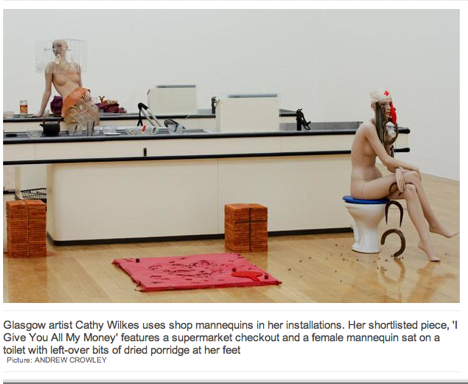
But rather than my articulating what is really a rank amateur’s opinion, here are appraisals from the British art critics:
To spend time in this show is like spending the afternoon in the departure lounges of Heathrow, Schiphol, Tempelhof and Charles de Gaulle airports. Physically you've moved from place to place, but, at the end of the day, you don't know where you've been. (Richard Dorment, Telegraph)
The annual frenzy of entrail-throwing that is the Turner Prize. (Charles Darwent, Independent)
If ever you were thinking of giving the Turner Prize a miss, not rushing down to the show at Tate Britain, not tuning into the televised ceremony, then 2008 is the ideal year. (Laura Cumming, Observer)
Some years ago, Art Buchwald wrote an unforgettable column on the breaking of the “four-minute Louvre” record. Written on the 40th anniversary of Roger Bannister's breaking the four-minute mile barrier in 1954, Buchwald described how a museum-goer in Paris broke a similarly unattainable speed record for seeing the Louvre. He zipped through the Louvre, that is, the essential Louvre -- Mona Lisa, Winged Victory and Venus de Milo – in less than four minutes! I was reminded of this achievement Monday when I’m sure I shattered all speed records for viewing the Turner Prize exhibition. (An excerpt from Buchwald's very funny column can be seen here in his Washington Post obituary.)
The Turner Prize this year was (appropriately?) demoted to the basement of Tate Britain. Wending our way upstairs, we took in the stimulating Francis Bacon show, allowing us to leave the museum with a better appreciation of British art, historically if not prospectively.
On to Tate Modern for the Rothko show. As Michelin might say, worth a special detour. The master in a masterful exhibition.
Across the river from the Tate Modern was an installation in the Thames of a floating artwork by our good friend from Louisiana and New York, Margaret Evangeline. Her piece is one of seven works that is part of Drift 08, a platform to enhance the London art scene by placing floating works along the river in central London.
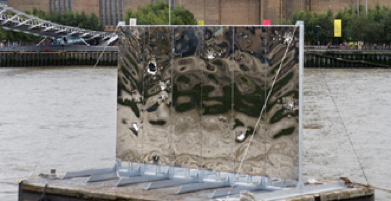
The British Museum special exhibition of Hadrian: Empire and Conflict was a treat. Hadrian, as I’m sure we all remember, reigned from AD 117-138, and ruled an empire that included much of Europe, northern Africa, and the Middle East.
The Frieze Art Fair in Regent Park was jammed, economic crisis or no. Surprisingly (to me), lots of painting.
At the new Saatchi Gallery, nary a pickled fish nor jeweled skull in sight. Instead, a surprisingly (to me)stimulating exhibition of contemporary Chinese art. One highlight by artists Sun Yuan and Peng Yu: a roomful of robotic, wheelchair-bound world-leader likenesses rolling around the floor, never bumping into the museum-goers or into each other. Art meets science meets satire.
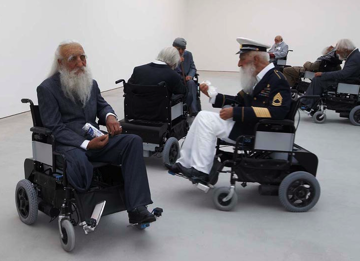
Other galleries around town benefited from the art collector influx for Frieze. Spent time at Waddington, White Cube and Alan Cristea, where a Julian Opie show just opened. Missed the Richter show at the Serpentine – had to save something for next time.
THE THEATRE SCENE
Although we live in New York just a few blocks from the Broadway theater district, and attend shows frequently, we feel this compulsion twice a year to fly to London to soak in the British theatre scene. Some reflections:
Acting: They do act well. Almost universally, even in the less than first-rate shows, the professionalism of the acting is striking. We’re constantly impressed by their diction and projection. (The latter quality is so often missing in the U.S. when film stars are on Broadway.) Maybe it’s because so many of the British actors train at RADA (Royal Academy of Dramatic Arts) instead of film or television, maybe it’s because so many of their résumés are larded with Shakespearean roles, maybe it’s because theatre is their first profession rather than their fill-in, maybe it’s because they have such great accents, or maybe it’s just because we’re Anglophiles. Whatever the reason, it’s rare that we don’t remark at the end of a play how outstandingly the lead actors and the ensemble performed.
Sound: Guess what? Amplified sound is not alive and well in London. Indeed, we’ve yet to hear an amplified voice in a straight dramatic show this week. On Broadway, where almost every show uses body mikes on the actors, the actors’ voices emanate from loudspeakers placed around the theater. Here, the sounds emanate from the actors’ mouths. How refreshing!
Ivanov: Not to be missed. A bravura performance by Kenneth Branagh, one of the finest, most versatile performers of our time. Tom Stoppard has adapted the Chekhov classic in a gripping, entertaining version. The large ensemble is universally terrific.
Creditors: Moving along from 19th-century Russia to 19th-century Sweden, this Strindberg play grips from start to finish. Whether focusing on the weaknesses of Chekhov’s characters or the flaws of Strindberg’s, these two plays go far to examine – painfully – the human condition. (BTW, the title "Creditors" is not related to the current credit crunch -- it refers to emotional, not financial, debts.)
Brief Encounter: Evoked by the 1945 David Lean movie, which in turn was based on an earlier Noël Coward play, this love story cum music-hall-revue cum farce cum movie misses often, but hits frequently enough to leave you with a smile on your face for most of the evening. Anyway, I’m a sucker for the Purple-Rose-of-Cairo technique of live actors magically dissolving into screen characters, and vice versa. Not a must see show, but not a disaster, either. (Faint praise, but what’s wrong with faint praise, anyway?)
Six Characters in Search of an Author: Pirandello was avant garde when he wrote this play 87 years ago, and it’s still avant garde. Almost impossible to describe – something to do with the question of what is real and what is fiction – it has to be experienced in what is a remarkably energetic production.
Now or Later: Well-reviewed by the London critics, but a rather modest, play about ethical choices facing a U. S. presidential candidate. A candidate who might say different things to different audiences? One who might try to hide family embarrassments? One who would do whatever necessary to get elected? Why, what presumption. I’m shocked, shocked. The British audience loved it. Can it be I’m getting too cynical?
Piaf: Revival of the “biodrama with music” (not listed as a musical, but it was a musical). Remarkable performance by (Argentinean) Elena Roger as the Little Sparrow, who sang all the songs in French, who inhabited Piaf in a stunning emotional display, and who received (what is fortunately unusual in London theatre) a standing O. But, oh, that creaky book.
The Norman Conquests: Another revival, this one of the wonderful 1973 Alan Ayckbourn comedy, albeit a comedy replete with poignant insights into the never-simple relationships between the sexes. A six-hour trilogy in one day – and it never flagged. Each of the three plays takes place contemporaneously in a different location of the same weekend house. As one reviewer wrote, be careful before you accept an invitation to spend a weekend in the country.
ON POLITICS
Today’s financial near meltdown: Quoting Abraham Lincoln, Adlai Stevenson said after losing the 1952 election in a landslide to Dwight Eisenhower, “ It hurts too much to laugh, but I’m too old to cry.”
As I’m writing this, the US stock market is down 4% after having plummeted 8% earlier in the day. For the year, the S&P is off 28%. A drop like this gets one’s attention. Some might say that blogging on a day like this is akin to Nero fiddling while… But what the hell, it beats looking at the tickertape.
ELECTION POLLS
Every day I check five different websites for their latest polling analyses. Each has some advantages. Here is a useful graphic or two from each of them:
538 (number of electoral votes)
The best analysis of the polls (by a young, baseball statistician). Weights polls as to their track record, timeliness, sample size. Obama surge is undeniable in last few weeks.
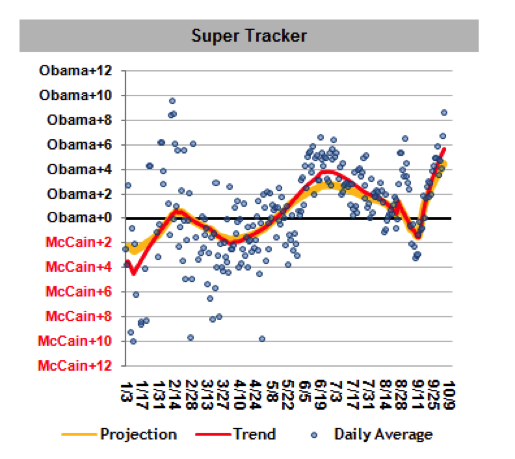
Shows probability of various electoral college outcomes. Suggests possibility of an Obama landslide.
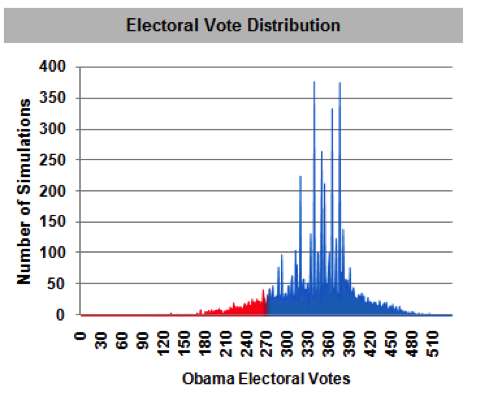
Chances of a filibuster-proof Senate are slim, about 20%.
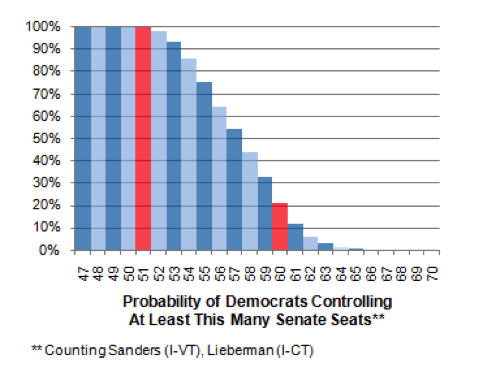
Pollster
Swing-state Ohio (Bush 51-49 over Kerry) has just gone blue.
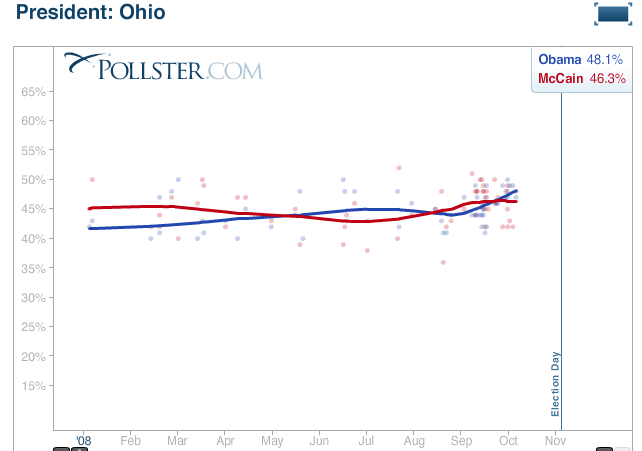
Key state Florida (Bush 52-47 over Kerry) also swinging into blue.
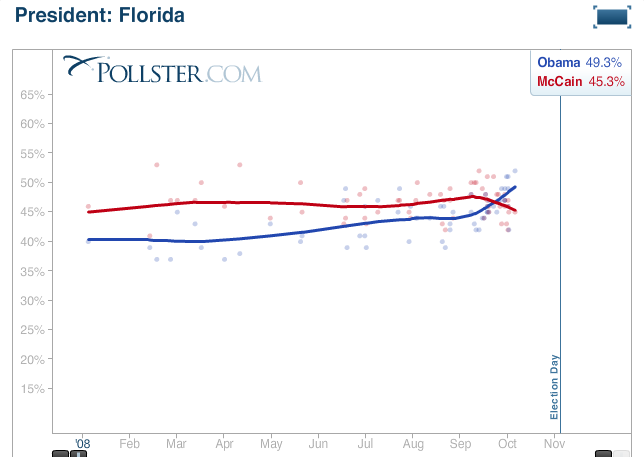
Swing state Colorado (Bush 52-47 over Kerry) moving to Obama.
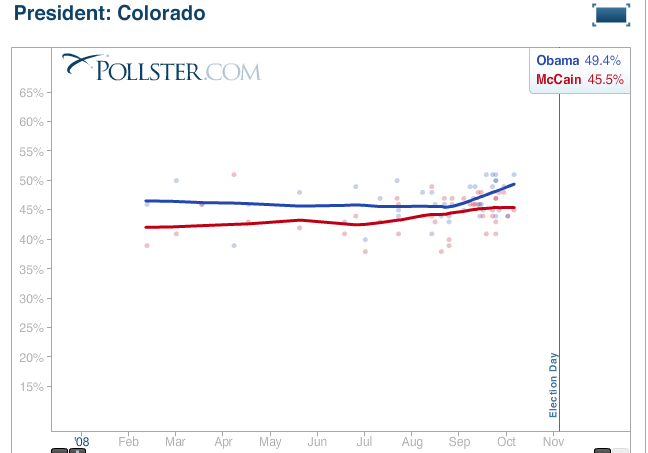
Gallup Daily
Gallup tracking poll surveys daily; provides a measure of sentiment changes.
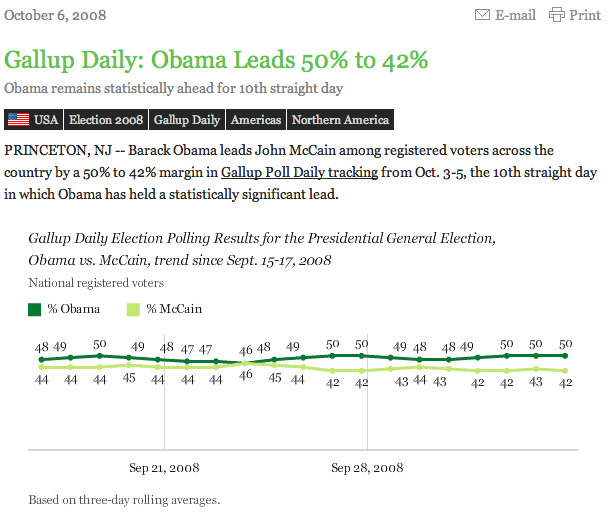
Real Clear Politics
Another useful average of all polls. Obama gap widening.
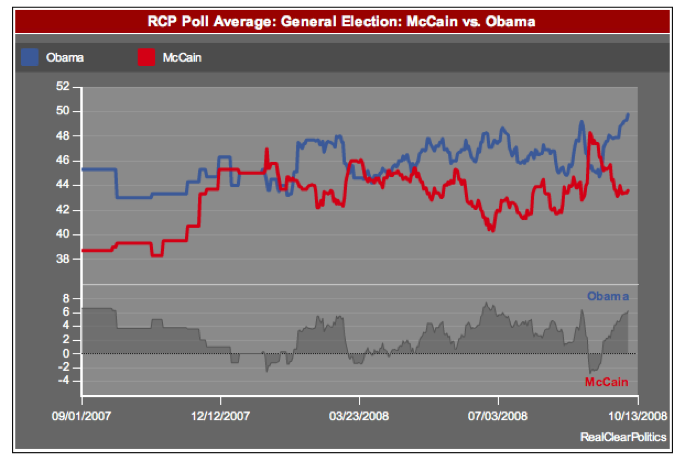
Good summary data, national and state.
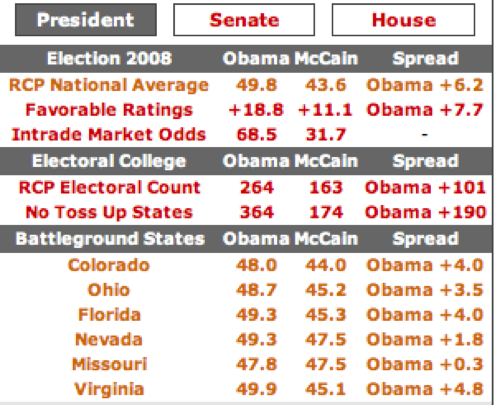
Electoral-Vote
Complete electoral vote information by state.
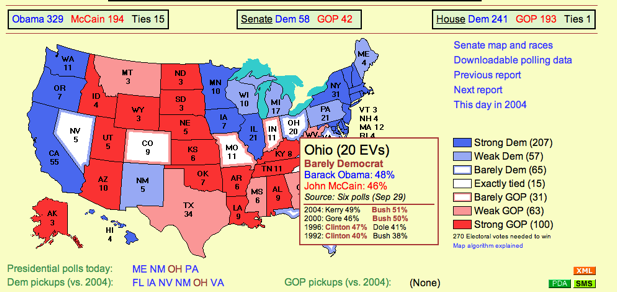
THE SMARTEST GUY IN THE ROOM
Hank Paulson may be in charge, but does the following quote from his interview in Fortune, July 12, 2007, give you confidence that he’s on top of the situation?
"On risks: We haven't had a global financial shock since 1998. I believe that these large and dramatic increases in private pools of capital [hedge funds and private equity] and in the credit derivatives markets since then have helped manage and disperse risk and make the economy more efficient."
ELECTION VIDEOS
In case you missed it, the Saturday Night Live spoof of the vice presidential debate was hilarious. Be sure to watch it here.
And also in case you missed it, there is a new mystery candidate who has just entered the presidential race. After you’ve watched the video here, you can follow the directions at the end of the video and nominate another candidate of your choosing.
BANKS CLOSING
On March 4, 1933, Franklin D. Roosevelt was inaugurated president of the United States. Seven days later I was born. That week, FDR closed all the banks in the country. I’m not sure whether his action was in honor of, or in despair of, my birth. Seventy-five years later we’re losing banks again. This time, I think I’m blameless.
QUICK QUIZ
Question: What happens on January 20, 2009? Easy. The 44th President of the United States will be inaugurated. Next question: What happens on January 21, 2009? Also easy. The campaign for the 2012 presidency begins.
SO MUCH FOR ECON 101
A physicist to the rescue: In my last post, I bemoaned the fact that with regard to the economic crisis, “nobody knows anything.” Certainly the results since then suggest the perspicacity of that accusation. Learned men and women have demonstrated repeatedly that their actions (and inactions) can successfully result in chaos in the worldwide marketplaces.
One fascinating explanation of the economic chaos was proffered by, of all people, a theoretical physicist in an October 1 op-ed piece in the New York Times. Mark Buchanan argued that “economists still try to understand markets by using ideas from traditional economics, especially so-called equilibrium theory. This theory views markets as reflecting a balance of forces, and says that market values change only in response to new information… Markets are otherwise supposed to have no real internal dynamics of their own.
“Too bad for the theory, things don’t seem to work out that way… Really understanding what’s going on means going beyond equilibrium thinking and getting some insight into the underlying ecology of beliefs and expectations, perceptions and misperceptions, that drive market swings.
“Surprisingly, very few economists have actually tried to do this, although that’s now changing – if slowly – through the efforts of pioneers who are building computer models able to mimic market dynamics by stimulating their workings from the bottom-up…
“The model shows something that is not at all obvious. The instability doesn’t grow in the market gradually, but arrives suddenly. Beyond a certain threshold the virtual market abruptly loses its stability in a “phase transition” akin to the way ice abruptly melts into liquid water. Beyond this point, collective financial meltdown becomes effectively certain. This is the kind of possibility that equilibrium thinking cannot even entertain.”
It may not be easy reading, but it’s stimulating. It’s true that rocket scientists on Wall Street have contributed to a wee bit of havoc in recent years by creating some esoteric derivative instruments, but perhaps nuclear physicists working in economics models can make a more substantive contribution. In any event, the thinking is fresh, unconventional and holds promise.
REFLECTIONS ON MUSIC
Mozart effect: Some years ago, there was research that suggested that young children listening to Mozart could benefit mentally, that it would actually make them smarter. Later studies, however, dismiss these findings. In any event, I think you’ll be amused by the following extensions of the Mozart effect to the benefits of listening to music by other composers – whatever your age. (Thanks to Zarin Mehta of the New York Philharmonic for sending me the following.)
A recent report says that the Mozart effect is yet another charming urban legend. The bad news for hip urban professionals playing Mozart for their designer babies: It will not improve his IQ or help him get into that exclusive preschool. He'll just have to get admitted to Harvard some other way.
Of course, we're all better off listening to Mozart purely for the pleasure of it. However, one wonders whether, if playing Mozart sonatas for little Jason or Tiffany really could boost his or her intelligence, what would happen if other composers were played during the kiddies' developmental time?
Liszt Effect: Child speaks rapidly and extravagantly, but never really says anything important.
Bruckner Effect: Child speaks v-e-r-y slowly and repeats himself
frequently and at length. Gains reputation for profundity.
Wagner Effect: Child becomes an egocentric megalomaniac. May eventually marry his sister.
Mahler Effect: Child continually screams -- at great length and volume -- that he's dying.
Schoenberg Effect: Child never repeats a word until he's used all the other words in his vocabulary. Sometimes talks backwards. Eventually, people stop listening to him. Child blames them for their inability to understand him.
Ives Effect: The child develops a remarkable ability to carry on several separate conversations at once, in various dialects.
Glass Effect: The child tends to repeat himself over and over and over and over and over and over and over and over and over and over and over and over and over again.
Stravinsky Effect: The child is prone to savage, guttural and profane outbursts that often lead to fighting and pandemonium in the preschool.
Brahms Effect: The child is able to speak beautifully as long as his sentences contain a multiple of three words (3, 6, 9, 12, etc.). However, his sentences containing 4 or 8 words are strangely uninspired.
Cage Effect: Child says nothing for 4 minutes, 33 seconds - exactly. (Preferred by 10 out of 10 classroom teachers.)
Tuning an orchestra: Not too long ago, Donna and I hosted a Philharmonic patron event in our apartment, where several orchestra musicians entertained. I hired our regular piano tuner, who happens to work for the Metropolitan Opera, to tune the piano. As was the Met’s practice, he tuned it to A = 440Hz (Hertz, or vibrations per second). The Philharmonic, I learned shortly after, tunes to A = 442Hz. I can’t believe that anyone can tell the difference between 440 and 442, but it turns out that real musicians can. So I had to rehire the tuner to re-tune all 88 keys. Whatever the frequency, the concert sounded great.
REFLECTIONS ON PROFESSIONAL FOOTBALL
Am I the only one who can’t stand the conservatism of professional football coaches? They seem so bound by conventional wisdom and tradition, doing what they do because they (and others) have always done it that way. They follow a philosophy of “lose the least” rather than “make the most.” As a result, he product suffers compared to what it could be. A potentially exciting sport has become turgid and formulaic.
Think of some of the really exciting plays you’ve seen (or heard about) in football, albeit rarely:
The halfback option, where the running back unexpectedly throws a pass (often for a touchdown).
A quick-kick on an early down, catching the defense without a returner in place (with the kick often going for a prodigious distance).
The two-point conversion to win a game (instead of that most boring of all plays, the extra-point kick, to tie).
A lateral by the pass receiver, who, after catching the ball, flips the ball to a teammate (who usually runs for a touchdown).
The reluctance to go for it on fourth down (choosing instead to punt, often resulting in a touchback, usually for a 20-or-so yard net distance).
And the excessive use of truly boring rushing plays (mostly up the middle).
Let’s look at the last two choices. If the chances of converting fourth downs were slim, it would be understandable that coaches almost always punt in this situation. But the data suggests the opposite. I went through the NFL statistics for all 32 teams during the 2007 regular season, and they shows the following:
Fourth down attempts: 533
Fourth down conversions: 261
Fourth down success ratio: 49%
I suspect that this success ratio is a lot higher than most people think. So it would seem to me that if a team is interested inwinning, rather than not losing, the number of fourth-down attempts would be a lot greater than the 2007 average of one per team per game.
And what about rushing versus passing? In 2007, the league-wide average gain per attempted pass was 6.8 yards. The gain per rush was 4.0 yards. Why, then, do they not pass more, given that the average passing yardage per attempt is 70% greater than per rush?
The conventional wisdom answer of course, almost a mantra, is that you need the rush to open up the pass. But is this true? Is there any data to support it? I don’t think so. And even if partly true, how much would you have to confuse the defense? Perhaps rushing 5% or 10% of the plays, instead of the 45%-50% now, would create enough uncertainty.
REFLECTIONS ON NEW ORLEANS
The Crescent City has certainly suffered a shattering blow from hurricane Katrina, not the least of which was the diminution of its population from the pre-storm 450,000 to the current 300,000. But well before this 2005 disaster, New Orleans was the victim of another set of disasters: incompetent, uncaring and crooked leadership at the local and state government levels. A tradition that began in the early 1930s by Huey Long. He started it, and many disciples and wannabes later perfected it.
Coupled with this lapse in political leadership was a failure from within the city’s citizenry. Ben C. Toledano described this source of urban decay eloquently in “New Orleans – An Autopsy,” an essay in the Sept. 2007 issue of Commentary magazine. (Ben C. and I were classmates from fifth through eighth grades.) He blames a large part of the demise on the practices and prejudices of the narrowly-based social and economic oligarchy that largely controlled the city.
My memory of growing up in New Orleans during the 1930s and 1940s was that we were first among equals of the four major southern cities; the others were Houston, Dallas, and Atlanta. Indeed we were the largest in population, we had the second-largest port in the country, we were in a state with immense natural resources, and we were certainly the most sophisticated and interesting city of the four.
Today, Houston and Dallas and Atlanta have left New Orleans in the dust. Yes, we still have the best food, the most interesting architecture, and the greatest music. But those three cities have left New Orleans in their wake – in population, commercial importance and standard of living. We’re more fun, but they offer their inhabitants much more economic opportunity and upward aspiration.
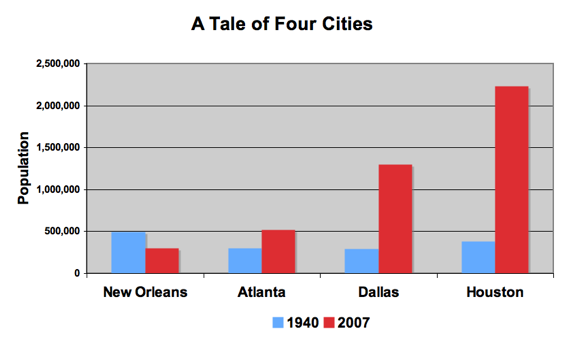
I have great hopes that the new governor, Bobby Jindal, will provide the necessary leadership to move the state and city forward. And in little over a year, New Orleans will elect a new mayor. The latter event can only be a positive development. In the meantime, I’m conjuring up ideas on what I can do to help rejuvenate the city commercially. The ideas are embryonic, but the enthusiasm is well developed. To be continued.
A FINAL, REALLY EXCITING, NOTE
As I write this at 7:00pm, I just received word that my all-electric Tesla Roadster (featured on 60 Minutes last night) will arrive at our Kent, Connecticut, home tomorrow morning. So what started out as yet another end-of-the-world-as-we-know-it day has suddenly morphed into something pretty electrifying, as it were.













